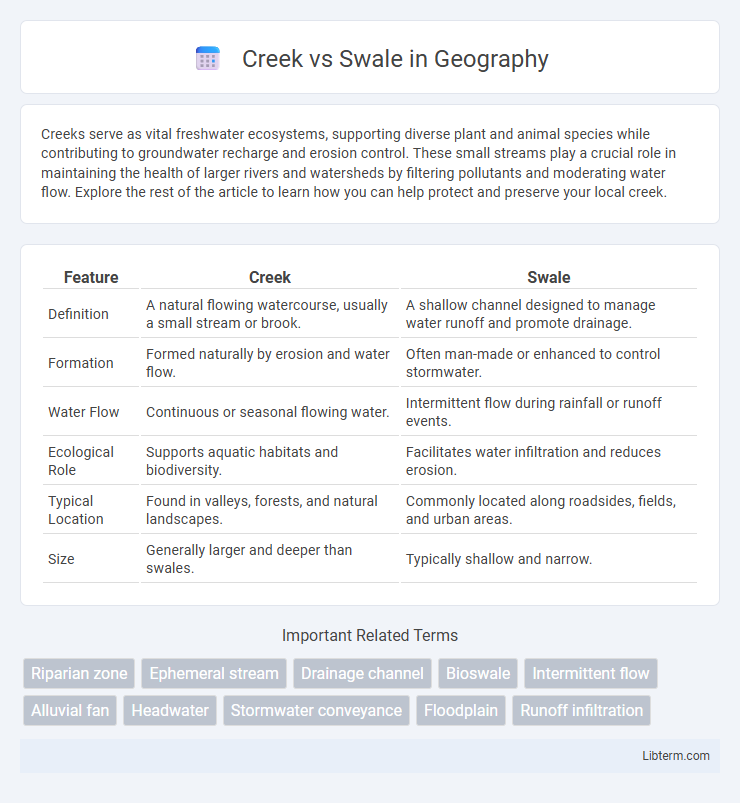Creeks serve as vital freshwater ecosystems, supporting diverse plant and animal species while contributing to groundwater recharge and erosion control. These small streams play a crucial role in maintaining the health of larger rivers and watersheds by filtering pollutants and moderating water flow. Explore the rest of the article to learn how you can help protect and preserve your local creek.
Table of Comparison
| Feature | Creek | Swale |
|---|---|---|
| Definition | A natural flowing watercourse, usually a small stream or brook. | A shallow channel designed to manage water runoff and promote drainage. |
| Formation | Formed naturally by erosion and water flow. | Often man-made or enhanced to control stormwater. |
| Water Flow | Continuous or seasonal flowing water. | Intermittent flow during rainfall or runoff events. |
| Ecological Role | Supports aquatic habitats and biodiversity. | Facilitates water infiltration and reduces erosion. |
| Typical Location | Found in valleys, forests, and natural landscapes. | Commonly located along roadsides, fields, and urban areas. |
| Size | Generally larger and deeper than swales. | Typically shallow and narrow. |
Introduction to Creeks and Swales
Creeks are natural watercourses that channel flowing water, typically forming part of a watershed or drainage system. Swales are shallow, vegetated channels designed to manage stormwater runoff and promote infiltration, often used in sustainable landscaping. Both play crucial roles in water management but differ in origin, function, and design characteristics.
Defining a Creek: Key Features
A creek is a narrow, natural waterway that typically serves as a tributary to larger rivers or lakes, characterized by flowing freshwater and defined banks. It often supports diverse ecosystems and influences local hydrology through continuous or intermittent water flow patterns. Key features include its meandering course, variable depth, and role in sediment transport and nutrient cycling.
What is a Swale? Essential Characteristics
A swale is a shallow, linear depression in the landscape designed to manage water runoff by directing and infiltrating stormwater into the ground. Essential characteristics of a swale include gentle slopes, vegetated surfaces, and the ability to slow down water flow to reduce erosion and enhance groundwater recharge. Unlike creeks, swales are typically man-made or modified for drainage control and do not maintain permanent flow of water.
Natural Formation: Creeks vs Swales
Creeks are naturally formed flowing watercourses, often with defined banks and continuous movement, shaping landscapes through erosion and sediment transport. Swales are shallow, vegetated depressions that collect and channel stormwater runoff, promoting infiltration and reducing surface water flow during rainfall events. Both creeks and swales play essential roles in natural hydrology but differ primarily in water permanence and their impact on ecosystem functions.
Hydrological Functions Compared
Creeks effectively convey surface runoff through defined channels, facilitating rapid water flow and reducing flooding risk in urban and natural landscapes. Swales, designed as shallow, vegetated depressions, promote infiltration and groundwater recharge while filtering pollutants from stormwater before it reaches larger water bodies. Both features contribute to stormwater management, but swales prioritize water quality enhancement and aquifer replenishment, whereas creeks primarily focus on efficient water conveyance.
Ecological Impact and Biodiversity
Creeks support high biodiversity by providing continuous water flow that sustains diverse aquatic and riparian habitats, essential for numerous fish, amphibians, and plant species. Swales, designed for stormwater management, create temporary wet environments that promote the growth of native vegetation and serve as critical breeding grounds for insects and amphibians, enhancing local ecological resilience. Both features contribute uniquely to ecosystem health, with creeks maintaining long-term habitat stability and swales improving water quality and supporting periodic wildlife activity.
Roles in Water Management
Creeks serve as natural channels that facilitate the flow and drainage of surface water, helping prevent flooding by efficiently directing runoff to larger water bodies. Swales function as shallow, vegetated depressions designed to slow water flow, promote infiltration, and filter pollutants before groundwater recharge occurs. Both play critical roles in stormwater management, controlling erosion, and maintaining watershed health through their complementary hydrological functions.
Usage in Landscaping and Agriculture
Creeks serve as natural water channels that enhance drainage and support aquatic habitats, making them ideal for landscape designs emphasizing natural water flow and biodiversity. Swales are shallow, vegetated channels designed to capture, slow, and filter stormwater runoff, commonly used in sustainable agriculture and landscaping to improve water infiltration and reduce soil erosion. Incorporating swales in agricultural land management aids in nutrient retention and groundwater recharge, while creeks often define property boundaries and create scenic water features.
Pros and Cons: Creek vs Swale
Creeks provide natural drainage and support diverse ecosystems but can be prone to flooding and require more maintenance. Swales efficiently manage stormwater runoff through infiltration and are cost-effective for urban areas yet have limited capacity and may not support large wildlife habitats. Choosing between a creek and a swale depends on site-specific factors like land use, environmental goals, and maintenance capabilities.
Choosing Between a Creek or Swale
Choosing between a creek and a swale depends on land topography, drainage requirements, and environmental goals. Creeks are natural or engineered watercourses ideal for directing larger volumes of stormwater and supporting aquatic habitats, while swales are shallow, vegetated channels designed primarily for slow water infiltration and runoff filtration. Prioritizing site-specific factors such as soil permeability, slope, and desired water flow management ensures optimal selection and sustainable watershed design.
Creek Infographic

 libterm.com
libterm.com